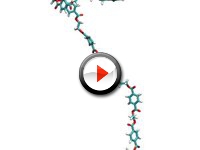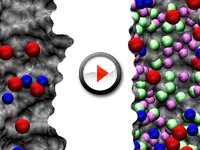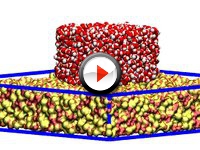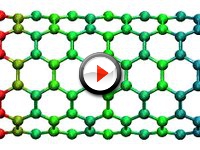Movie Gallery - Nonprotein
All movies and images were made using VMD. Download movie files via the movie file type (.mpg, .mov) after the movie title (right-click in Windows; control-click on Macs). To view original movie files, you may need to try the Quicktime or VLC movie players. You may wish to also visit TCBG's YouTube movie gallery to view science movies. All movies are copyrighted by TCBG.
 |
Building Bulk Plastic for Nanopores (.mov, 18.5M) | ||||
| Polyethylene terephthalate (PET) is a linear polymer widely used in beverage bottles and other plastic containers. The movie illustrates the collapsing-annealing procedure used to build amorphous PET, for use in making nanopores. In the first stage, 245 PET polymers are arranged into a grid. Each polymer is presented in different color. Then, the grid is collapsed into a rectangular box. In the second stage, the collapsed grid is moved into a periodic box and annealed to obtain homogeneous density. The collapsed structure is colored in red and the periodic images in blue. A nanopore can then be cut from the bulk PET material. The combined stages take place over a period of 13.2 nanoseconds. | |||||
 |
Ions Moving Through Smooth and Bumpy Pores (.mpg, 1.2M) | ||||
| Understanding how ions move through nanopores can aid in designing tools for sequencing DNA. The movie shows potassium (blue ball) and chlorine (red ball) ions moving through a smooth (annealed) pore on the left, and a raw pore with dangling atoms (oxygens in purple, silicons in green) on the right. Ions accumulate (are adsorbed) by the dangling atoms at the raw pore surface, slowing their passage through the pore. | |||||
 |
Equilibration of a Water Droplet on a Hydrophobic Annealed Surface (.mpg, 121M) | ||||
| The movie shows the dynamics of a drop composed of 2000 water molecules (red and white spheres) on top of a glass slab (yellow and magenta in blue box). The starting configuration corresponds to a water disc and the system was computer-simulated for 2 nanoseconds. The water contact angle (WCA), the angle between the tangent of the water droplet and the solid surface, characterize the affinity between water and glass. The WCA value can be reproduced by computer simulations. | |||||
 |
Ion Conduction through Silica Nanopore (.mpg, 7.2M) | ||||
| The movie shows salt (brown and cyan atoms) dissolved in water, moving though a very small pore of 0.000002 millimeter diameter built on glass. The red and yellow colors depict the different atoms of the glass structure. These small pores have many potential applications, such as DNA sequencing. Due to their small size, the properties of the pores can only be studied using computer simulations. | |||||
 |
Ion-WSNT Terahertz Oscillator (.mpg, 395k) | ||||
| A potassium ion interacts with a 16 Angstroms carbon nanotube. The ion induces a strong dielectric response in the nanotube wall that can be described by a self-consistent tight-binding method. | |||||
| |
|||||



